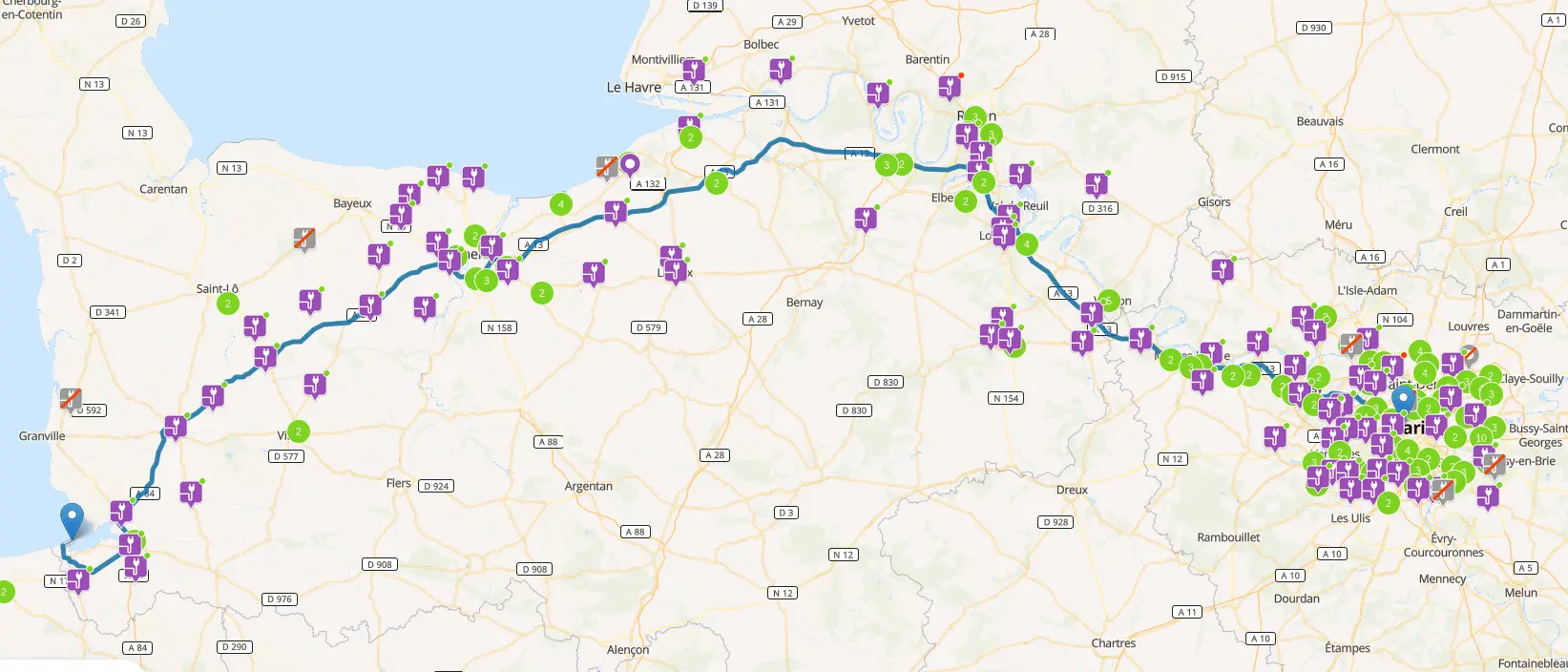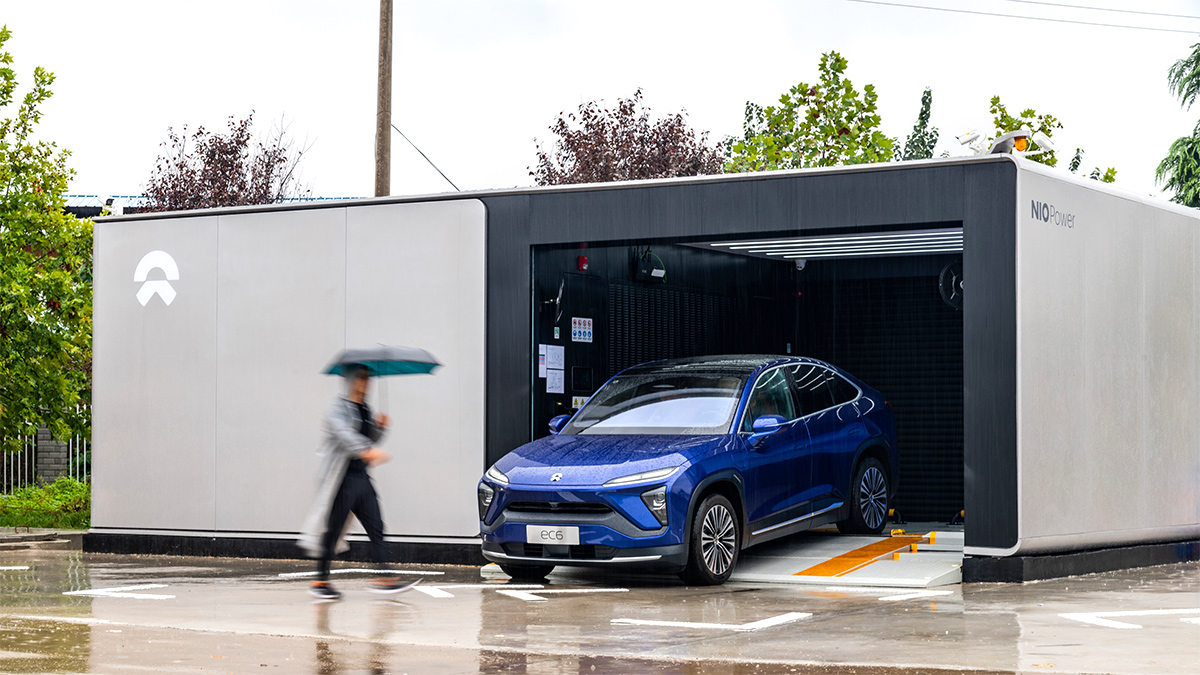See, Apple? Even cars can do it :)
The answer is massive government support. The cost of those stations has to be insane…imagine the inventory holding cost of those batteries
Imagine the cost of stations everywhere that would have tanker-trucks deliver fluid that you’d put in cars
Well yeah but the comparison here should be against a typical BEV. ICE cars are already being phased out regardless.
Don’t worry, the US government will support its automakers by banning the competition.
That is, if they make totally cool and totally legal campaign contributions.
Competing is for the working class, not the 1%.
I think swappable batteries could be a good solution to fires and probelms seen with long term battery health. Like if batteries were smaller and you swap it out rather than charging they could be inspected before being redistributed. In an ideal situation the cost of purchasing a battery would be removed from the vehicle price and shift to a subscription/interchange system. It could help consumers if their battery goes bad by not needing to buy a completly new one and prevent fires. Unfortunately, everything is terrible and I imagine this would inevitably turn to some kind of scummy, overpriced, preditory system. I am not sure if damage caused by batteries is enough to justify such a program but I think insurance companies and governments have or will look into it.
They’ll make it illegal to charge your own battery. And enshitification will guarantee perpetually rising prices, lower and lower range batteries, or some combination of the 2.
Ah so this is about swapping the battery on-the-go so you can get rid of your depleted one and get a freshly charged one within minutes.
That’s actually pretty cool then!
Not quite sure how this relates to Apple though.
It’s a joke about how apple made their phone even thinner and the battery still isn’t removable :P
When 52% of all trips made are less than 3 miles and less than 2% are over fifty miles, I don’t think battery swapping is something any individual needs on a regular basis.
I could get on board if manufacturers were making $10,000 sub 50 mile vehicles that were compatible with a swap station so you could switch to a larger battery for the weekend. This would have to be a standard adopted by all however, and even before that, they’d have to make small cars. Which they won’t, because we all know they are too busy making trucks and SUVs.
The whole “but what about the one journey a year you make that’s outside the normal battery range?” is such an obvious fossil fuel industry boondoggle. It’s up there with “but what about that one time you had to move a fridge?” when convincing people that a Ford F150 is a normal sized family car.
I’m also thinking that way wrt to “we need more fast charging for EVs to work”, I recall that plugging into a standard outlet will get you something like 5-8 km an hour, slow charging is totally acceptable for most people’s usages. If you’re in an area where block heaters are the norm you already have outlets at parking spots, if I could commute to work and plug it in, covers most commutes in a 8 hour day, even those of us who rarely go in and live 70k away I’d be getting most of my range back. For the amount I drive, level 1 charging is more than sufficient.
I think a compact with 2-300 k range would suit me just fine, would cover the odd longer trip and I’ll totally grab a rental for anything longer, like I already do it I need to move a fridge.
hear hear for small cars
PS: and walkable/cyclable cities
Do people even need a car for a 3 miles trip? You can cover that on a bike in 15-20 mins at a chill pace… Also, 28% of trips are less than a mile? People can’t walk a mile?
Not speaking for other places, but America is not made for bikes or pedestrians. It is actively hostile to them in the best cases, and filled with explicit murderous intent in others.
Drivers will actually, actively, try to hit you for daring to take to the roads. And you have to take the road because we have sparse or missing pedestrian sidewalks.
I wouldn’t wish biking 3 miles in most American cities on anyone used to a properly designed nation.
Sadly, you are speaking for a great many places. I’ve cycled in most of the countries I’ve visited and it can be relatively dangerous.
If people want to see how to integrate a public transport network with a cycle path network, places like Netherlands and Denmark are leading the way.
Over here in the UK we have one of the most regressive attitudes to sustainable transport in Europe. Our trains don’t work and cycling is barely tolerated.
This is just anecdotal, but as someone who both drives and cycles in the UK, I’d say it’s city dependent. I live in Leeds, go to uni in Leeds and work in Huddersfield. I cycle to uni, cycle to the train station and drive to work (when I can’t get a train for whatever reason). Leeds is getting there, albeit slowly but it’s getting alot better for cyclists. I like the electric bicycle scheme so I can cycle to the station and just leave the bike there. although it shouldn’t be more expensive than getting a bus.
Not everyone is child free and lives where it doesn’t rain
The Dutch do it… Rain or shine (mostly rain with crazy wind) with their cargo/kid bikes.
I am Dutch
So just lazy then?
I live on the Dutch coast and still cycle despite constantly shit weather.
I have 4 kids. Stop acting like a rodent.
Sounds like you’re stressed from all those kids! Have you tried cycling? It’s a great outlet and stress relief
Holland is also flat as fuck
Would be good for hauling large objects
I doubt the average person needs to do that daily over such a short distance.
I think an automated battery swap system would work best for OTR trucking. Pull in, battery packs swapped, off they go. The charge for much larger batteries would take longer, or at least would be better done not attached to a vehicle for maintenance or in case of thermal problems.
There’s a company doing this already. Giant battery sits behind the cab. They drive up, unplug it like a LEGO with a huge robot arm, plunk in a new one and good to go.
I think an automated battery swap system would work best for OTR trucking.
Yes, that and other commercial vehicles that put on a lot of miles in a day, every day.
Not to mention, most of these trucks are very standardized in their dimensions and parts already. This is probably the biggest thing that will hurt small vehicles is picking a subset of standardized dimensions that will fit multiple models.
The example of driving from Paris to Mt St Michel where you have to plan carefully to get to ‘the only supercharger’ east of Paris is a bit stupid. Why not charge at Total, Engie, or even Lidl? I assume Teslas are not exclusively charged at superchargers, which can be pretty slow at 150kW when there are 300kW options as well.
A good and in France rapidly improving charging network is important, swapping batteries sounds nice but brings so many compatibility and standardization issues, not considering ownership/lock-in etc.
I stopped reading the article there.
Either the author is voluntarily misleading or he has no idea of what he is talking about.
Here is the map all the fast charging stations (>100kW) along the way between Paris and the Mont St Michel.
The Tesla model 3 in Europe uses the standard combo CCS plug so it can use all of these stations.

I did not count them but at a first glance the number of charger is higher than “none”
Edit: OK I read the article after all but I really don’t see what problem battery swapping would solve.
I could see a use case for public transport that has to go a specific road and need to run non stop every days but even then I suspect that having overhead cable on a short section to charge the battery while running would be more appropriate than battery swapping.
The article is talking about the lack of charging station but battery swapping just make the problem way way worse. A battery charger is just a parking spot and a high voltage AC - DC transformer connected to the grid. It’s relatively cheap and easy to install, does not take much space and work for all electric cars compared to a battery swapping station that can only work for one specific brand (specific model too ?) need robotics and plenty of storage. Its much harder and expensive to install and you need one charging station per brand. This means less stations overall.
Finally there is the speed of charging, this is true that battery swapping is probably faster than fast charging but honestly I don’t find charging an electric car that inconvenient.
On long highway trips I need to stop around 20 minutes every 2 hours, a 20 minutes break every 2 hours is not that bad, just enough time for a toilet break, a quick coffee before going back on the road.
The cost to install stations would dramatically reduce if you had one stations that could supply 20 parking lots instead of one station for each two lots.
It also shuts up all the complaints about batteries going dead and the cost of replacing them.
I do agree ice vehicles are already very convenient and most people complaining are mostly just parroting oil propoganda, but making them even more convenient isn’t a bad thing.
I don’t think many run their batteries to the ground but it’s nice to know someone can just bring you a spare if you do.
for one specific brand (specific model too ?)
Probably one platform (used for several models, sometimes shared between brands. For instance VW Polo, Audi A1, Seat Ibiza and Skoda Fabia are all based on the same platform).
Unless you have cars with modular battery packs, which do not exist right now.
Tesla drivers are c*nts anyways :p Focus on proper EVs.
I think it’s great to see this happening. I’ve always thought this option makes sense. I still wish the solution was a drone that comes right to you and drops a battery into a port on your roof while you are still driving, but I guess that is going to have to wait.
I want to see someone try.
Not because it’s practical, or because it makes sense. But because it sounds like it makes sense but I’m practice would be so impractical and hard that the solution would be absolutely hilarious.
You’re driving along the freeway at 70 miles an hour, and a jet powered super drone rockets along side the car carrying a 2000 pound brick of lithium and drops it on top of you like a fucking dump truck. The shock crushes the cheap Chinese car like a can of soda and the sudden change in weight sends the drone careening off in to the air at a reasonable percentage of mach 1. The last thing you see on this earth as your brain matter is squeezed out of your eye sockets like toothpaste is a wide eyed driver in the car next to you.
The resulting pile up kills 4 people immediately, and several more later as they get caught in an expanding wave of lithium battery fires that either burn them to death or suck all of the oxygen out of the air.
Did the car get successfully recharged though?
It certainly had more chemical energy added to it, so… yes?
Sounds good. Let’s work on the business plan. ;)
Gotta start somewhere right?
I can see so many issues with what you’re proposing, but hey auto grenade dropping drones have great military application
“Battery Station” vs. “Gas Station” should’ve been a no brainer from day one.
Next best plan should be “electric roads” that are powered by green tech.
Of course it all would be massively expensive. Sadly, it’s clear that the powers that be to protect Earth’s climate do not give a shit.
It’s a no brainier, until you deal with standardizing the battery and attachment mechanisms across many manufacturers. Then figuring out the machines necessary to automate the process of removing the battery and swapping in a new one. Then dealing with people who abuse their battery and bringing them to EOL early. Then deploying all of that nationwide.
Oh, and it limits where you can place the battery. You can’t integrate it into the frame, which has some big advantages in reducing weight.
Conversely, charging stations are relatively easy. You need to standardize the plug, which ain’t nothing, but it’s far easier than an entire battery release mechanism. The charge stations themselves aren’t much more than a transformer, some high voltage electronics, and some controls. Again, not nothing, but way easier than an automated garage for battery replacement.
Charge stations were always going to be able to race way ahead in deployment timelines, and we still don’t have enough of them. If we had focused on battery swap stations, we’d be even further behind.
Highways could totally have power lines overhead…the problem is just finding the best way of getting it to the car safely (I don’t like the trolley-style solution).
Not sure what the “trolley style” is.
My exposure to electric roads are electro-magnetic rails under the road that provide a constant electric field that cars drive over.
Honestly, I think it may be possible to build entire roads with enough crushed metal elements in the asphalt/concrete and a slight low power charge throughout the entire surface would be able to keep any vehicle battery at a steady charge.
But, I’m not a scientist/engineer/electrical specialist, etc …
Trolly style = hooking on to an over-road power line.

Yes, I should’ve known. It was a popular thing in my area with a bus line that stopped just within the past 3 years.
Honestly, I think it may be possible to build entire roads with enough crushed metal elements in the asphalt/concrete and a slight low power charge throughout the entire surface would be able to keep any vehicle battery at a steady charge.
You might be underestimating how much power a car consumes while driving. For example, a Tesla model 3 has an efficiency of about 130 Wh/km in mild weather at highway speeds. Assuming that on the highway you’ll travel 100 km/h, that means you’ll use 130*100 = 13.000 Wh/h, a constant power draw of 13kW. That’s enough to power perhaps 8-12 houses on average.
A km of road could have, let’s say, 200 cars on it (4 lanes, 20m per car). That means you’d need to pump about 2.6 megawatts of power into every kilometer of road to keep them all topped up.
EDIT: fucked up math
And that doesn’t seem to take into account transmission losses. Even the best wireless phone chargers are maybe 70% efficient. This may hit 40% if you’re lucky. So double that figure.
Does using a period in your number not cause confusion? 13.000 vs 13,000. I first read it is 13 since the zeros mean nothing following a period where im from. No shade, just curious.
Apologies. I’m from a country where the meaning of the period and comma is reversed compared to the US, so I did it this way out of habit.
No need to apologize. I didn’t know they were reversed. Do yall do periods for three digits? 1.000.000,00?
Yup, just like that
deleted by creator
- Book a swap in the app
- arrive in the lineup.
- serves one car at a time like an oil change
- the station has to constantly be charging the used batteries.
Or
Install 4-6 high speed chargers in the same spot and clear more cars faster .
Essentially the swap station is only better if you arrive without a lineup. The swap takes 7-10min and is manned. If you are one or two cars deep waiting you are better to have just found a charger
Why wouldn’t you compare like situations? It appears you chose a rather well set-up charging station vs. a poorly setup swapping station.
I didn’t picture an oil change when I imagined a battery swap station, I am not sure that should be the default or starting point.
neo is the ONLY company doing swap stations, and that is how they work… I also described current, available EVs with available chargers.
True, mass parallel charging can fulfill more peak demand faster, but from the point of view of the user, it would still be good to have the option to fill/exchange the battery quickly.
An EV6 on an capable fast charger can do 10% to 80% in 17 min
They need to make the swap faster / higher throughput or charging is still going to make more sense .
One thing that would speed it up would be if you could just drop the 1-ton battery by gravity (safely, which I understant is hard on the edges of any hooks holding it, maybe they could use a raised floor, which is what they do in NIO) and snap it back on in 30s or less for a total of 2m. The rest is just your usual parking, pulling the gas hose. Maybe make it go-through so you don’t have to manouver into place.
More like install 8 to 12 DCFS at a minimum and some very busy stations have a massive amount of chargers.
No I would not. Chargers work just fine.
My colleague has a NIO car like this, he really likes it and uses the battery swap weekly. To my knowledge they have patented the tech.
If I bought an electric car, I would definitely consider NIO, as this option is great for long trips. In EU they have a couple of swap stations in Germany, but it’s still a long way to go in other countries.
deleted by creator
deleted by creator
Nah, we already use it:
https://www.nio.com/news/NIO-reaches-30-Power-Swap-Stations-in-Europe
https://www.youtube.com/watch?v=hNZy603as5w
We just need to get our heads out of the sand and take these challenges from China seriously in the EU and the US with proper coordinated reindustrialization policies. Tariffs and bans only buy us time.
I know it’s not “apples to apples” but swapping giant forktruck batteries (I assume they were lead-acid) has been done for decades too. I think we did it at Sam’s Club, at least for when the batteries wouldn’t charge.









